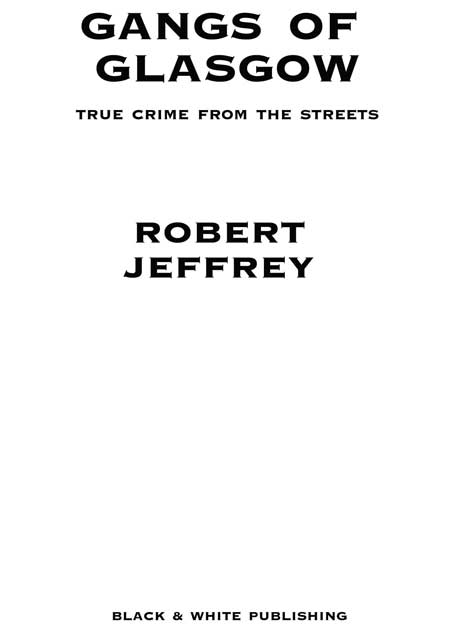
I would like to acknowledge the assistance in the production of this book of Marie Jeffrey, Samantha Boyd, Rod Ramsay, Stuart Jeffrey, Ian Watson, the library staff of the Scottish Media Group, Elizabeth Carmichael and the friendly and efficient staff of the Glasgow Room in the Mitchell Library, Catherine Torretti of the Daily Record and the senior researcher Stroma Fraser, a Scots/Australian librarian whose enthusiasm is both enormous and infectious and whose expertise was invaluable.
RJ
Carradale, Argyll
CONTENTS
1
The story of the gangs of Glasgow teaches a hard lesson. They simply refuse to go away. Crimelords rise and fall, Chief Constables come and go. In the war against big city violence battles are won and lost. But the gangs are an enduring blight on a city that in many other ways an impressive growth of modern architecture, burgeoning tourism and a new flourishing climate of culture and the arts has transformed itself. In fact the changing face of Glasgow is as impressive a success story as you will find anywhere in the world. The problem with crime is far from unique it is hard to think of any city, particularly a seaport, with a similar historic background of heavy industry, poverty, and poor housing that does not have a residual problem with violence and drugs. Glasgows problems cannot and should not be swept from sight.
The ongoing nature of crime in the city can be demonstrated by recent events at the infamous BAR-L, the nickname every Glaswegian uses for Barlinnie Prison, the huge, grim edifice glimpsed by drivers passing through the east end on the busy M8. In April 2008 the Chief Inspector of Prisons, Dr Andrew McClellan, told the BBC that the BAR-L was running at 50 percent over capacity. A percentage of the inmates might be minor offenders who could have been dealt with without the need for a custodial sentence, but the fact remains that Barlinnie is still bursting at the seams with hard men despite the activities of a succession of gang busters down the years.
The most recent crimelord, Tam The Licensee McGraw, died from an apparent heart attack in July 2007 a somewhat ironic demise for a man who for years was at the heart of violence in the city and who had many serious enemies among the players on the streets. Many saw it as the end of an era.
For a number of years McGraw and Paul Ferris now claiming to be a reformed character had been the names in the tabloid headlines, the public face of the evildoers in the city. But they were only the latest in a long line stretching from the end of the nineteenth century to today. The earliest of the gangs is said to be the Penny Mob and they and similar outfits dominated their own era. In similar fashion the Brigton Billy Boys (led by the legendary Billy Fullerton) and the Norman Conks (led by Bull Bowman) made the headlines in the thirties. In this era the most famous of all gang busters and Chief Constables Sir Percy Sillitoe often met violence with violence and headed a police force that had considerable success in this most violent of criminal times in the city.
The Second World War ended that particular crusade against crime. And after the Hitler war was won there were new battles on the streets and the emergence of such Godfathers of crime as Walter Norval and Arthur Thompson Snr. McGraw and Ferris walked in the footsteps of such men.
In the years just before and just after the turn of the twentieth century the city was enjoying one of its cyclical periods of relative calm when Glaswegians view of their city was cruelly jolted back to reality in the spring of 2002.
There was another of the regular sea changes in crime in the city that have occurred down the years. Suddenly violence had reappeared on the agenda. The renaissance brought about by the Year of Culture, the Garden Festival, the new Concert Hall, the Burrell collection and the seemingly unstoppable growth of book-shops, trendy restaurants and pavement caf life was somewhat overshadowed by dramatic events on the streets.
The return to the bad old days of inter-gang warfare, of evil factions fighting for power and turf and settling old scores in the nastiest of ways, was particularly shocking simply because for some years much of the reporting of it had largely dropped out of newspapers.
The citizens of the Dear Green Place had begun to believe their own publicity a little too much. The old city, now with the grime on tenement walls blasted away, and new exciting city centre and riverside architecture providing a superficial gloss, was, however, shown to be not as far removed from its old reputation as something akin to a Chicago of far north west Europe as the douce burghers had grown to believe.
In April and May the fashionable caffe latte-sippers had their attention jolted from the latest pontificating arts reviews that take up so much space in the citys papers these days, and found themselves once again reading of the doings of old-fashioned gangsters. The concept of these new battles for power is little different from the past. But the style of the warriors is far removed from that of the gangsters of the twenties or thirties or indeed the hoodlums and corner boy gangs of the seventies and eighties. Control of the drugs trade has become, for the major gangs, the main driving force. There are still battles in the schemes between small groups of youths staking claim to territory and fighting over their molls. Indeed there is a massive upsurge in knife-related crime across Scotland, not just in Glasgow. In the clich of the tabloids, blade culture is back.
In the six years since the watershed of the return of violence to the headlines the culture of the knife has continued to grow. 2002 marked a return to bad old ways, and on several occasions since then there have been headlines and incidents that dwarfed the bloody past. Early in 2006 a conference in the city was given dramatic confirmation of the problem. A top casualty surgeon graphically described the injuries of victims wheeled into the operating theatre on Friday and Saturday nights.
Eight years into the new century street violence is as rampant as it ever has been. Skulls are still cracked and faces disfigured.
But if knife-carrying and booze and drug-fuelled rumbles at the weekend is a return to old ways, it is rather different for the major players in gangland. Now the gangster is no longer a sad-looking loner in a sleazy bar with his pallid chib-marked face showing him to be a man of many disputes, perhaps mad, perhaps bad, but certainly dangerous to tangle with.
The hoodlum of the twenty-first century presents a different face to the public. Even if the city still had its famous shoogly trams you can be sure he would not be taking them, even to ride about the streets of the east end where so much blood has been spilled over the years.
The preferred method of transport for the big boys these days is the 4x4 recreational vehicle, heavily chromed and as powerful as possible. The hell with what the green lobby might think of these vehicles and never mind that such a status symbol of a vehicle is destined never to muddy a tyre with off-road excursions other than a quick trip up a rutted and unlighted back alley where a little business might be done.
Behind the wheel will be a man with the expected gold jewellery dripping from every visible part of his body. His suits are designer gear bought with no thought to expense and some would say even less to taste. One item of clothing though is shockingly standard a bullet proof vest.
The home of such a man is mostly likely be an expensive pile in a desirable suburb. The days when godfathers lived in a tenement flat surrounded by the people whose lives they bilked and blighted are long gone. The house will perhaps be decorated in a style not familiar to the neighbours. But the neighbours in the leafy avenues will note with little surprise that the boot of the four wheel drive recreational vehicle contains an expensive set of golf clubs.
Next page















